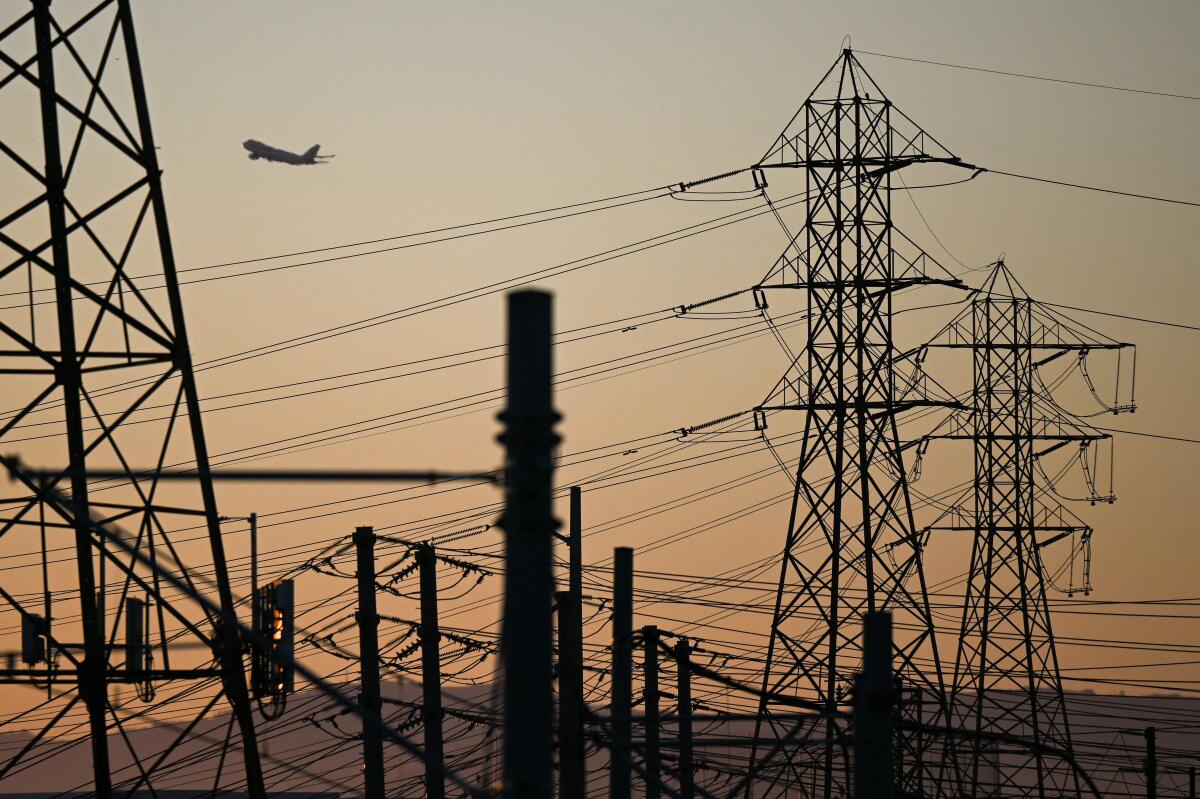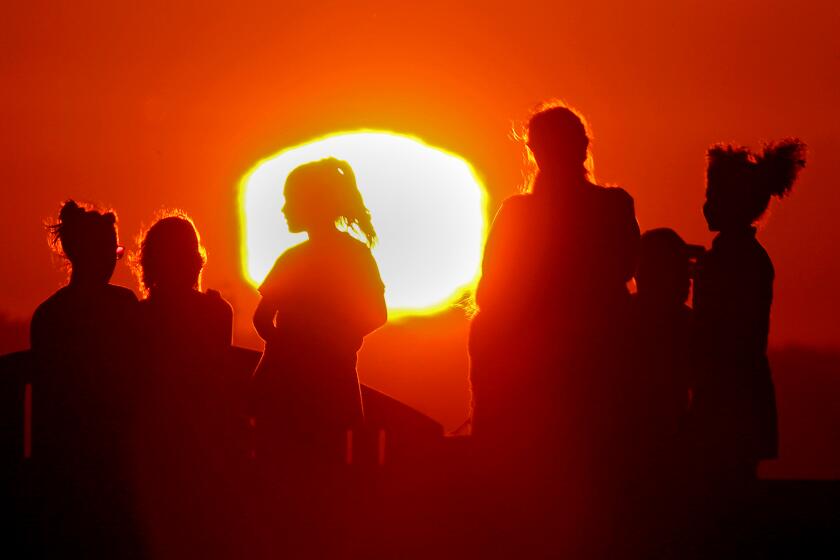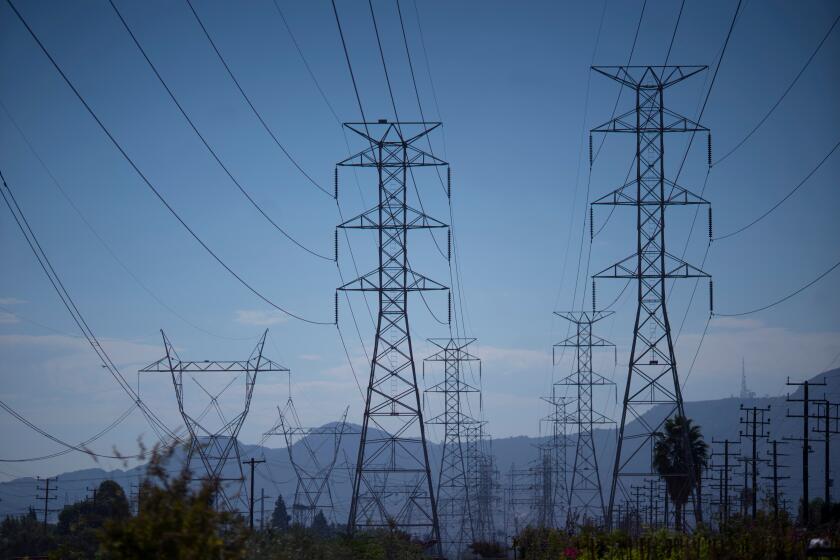California has new weapons to battle summer blackouts: Battery storage, power from record rain

- Share via
It’s a summertime sequence that’s become all too familiar in California: Extreme heat forces air conditioners into overdrive, which pushes the state’s power grid to the brink.
In August 2020, a major heat event fueled by the climate crisis forced some of the state’s first rotating power outages in decades, as the ongoing transition to green energy lagged behind demand. Last September, Californians narrowly avoided rolling blackouts as a record-breaking heat wave broiled almost every corner of the state for days.
Now, California is trying to avoid a repeat this summer as global warming pushes temperatures higher and for longer stretches of time.
As an unrelenting heat wave across the West nears the start of its second month, officials said the risks remain high. But they are hopeful they have new tools at their disposal, including substantial growth in battery storage, increased hydropower thanks to historic winter rains and storms, and backup resources available through contingency plans.
State officials say the winter’s wild weather helped refill hydropower generators, decreasing the risk of dangerous electricity outages this summer.
“We’re feeling more confident in [California Independent Service Operator’s] ability to get through the summer, and more resources are getting added to the grid,” said Ric O’Connell, executive director of GridLab, a nonprofit focused on power grid transformation. “In general, we’re doing better this summer because we have better hydro, we have more batteries.”
Since last summer, California ISO — the nonprofit that runs the state’s electric grid — has brought more than 2,000 megawatts of new battery storage online, an almost 75% increase in capacity, officials said. And that’s expected to continue.
“The batteries are important, because they charge during the middle of the day when we have surplus solar production and discharge that energy onto the grid in the evenings, when solar is ramping off the system and we’re trying to fill the gap in supply,” Anne Gonzales, a spokesperson for the California ISO, wrote in a statement.
California ISO just reached a record high of battery charging this week — almost doubling the peak from a year prior, according GridStatus, a website that tracks independent service operators. And compared to data from last summer’s heat wave, California ISO’s energy supplies this week have already relied more heavily on battery supply during peak hours, according to supply data.
California’s first heat wave of the year could last into next week. Here are some tips on how to stay safe and cool during hot weather.
One megawatt of electricity is enough to power about 750 homes. And while renewable resources have exponentially increased in recent years, it’s worth noting that natural gas still fuels well over 40% of the state’s power most days.
But even with additional resources available this summer, officials say nothing is for certain in our changing climate.
“This year, we predict no shortfalls under average conditions,” Siva Gunda, vice chair of the California Energy Commission, said in a May briefing. “Extremes of climate change remain a wild card — another extreme event like last summer could once again put the grid into vulnerable territory.”
He predicted that a situation like last September — when the grid hit record-high demand, at about 52,000 megawatts — could likely be managed with the state’s contingency resources and additional market procurements. But if faced with another challenge such as a major wildfire or provider outages, Gunda said, the grid could fall short.
Death Valley, one of the most extreme places on the planet, is already seeing the impact of climate change, with summers even hotter than usual.
Grid operators already have issued multiple energy emergency alerts during the last few days of the heat wave, albeit at the lowest priority. Rolling blackouts or Flex Alerts weren’t a real concern, officials said, though high demand and high temperatures forced the need to unlock additional energy supplies.
“We got some luck during the July heat waves, because while inland temperatures were hot and in some cases above normal, the direct coastal temperatures didn’t get extreme,” Gonzales said, noting that cloud cover and the cooler coasts have kept demand for energy well below prior records. “We haven’t hit particularly high demand yet.”
Even still, California ISO last week issued an energy emergency alert 1, noting “higher than anticipated demand,” but ended it an hour later. Then this week, officials issued two energy emergency watches — the lowest warning — citing Wednesday “some resources going offline, continued excessive heat in interior Southern California and transmission congestion restricting movement of power to parts of the state.”
But data shows demand, even at peak hours, never quite flirted near capacity as it did repeatedly last September.
Officials credit the emergency alert sent Tuesday night for the avoidance of widespread blackouts during record-setting energy demands.
“So while we haven’t seen substantial stress on the grid this summer, we haven’t been fully tested,” Gonzales said. “August and September historically can be times of stress on the grid.”
In the later summer, heat often becomes more extreme and wildfire activity increases, the latter of which can take out major transmission lines or generation. That time of year also becomes drier and days are shorter, reducing hydro and solar power, officials have said.
“Even though we see an improved situation for this summer, folks shouldn’t be surprised to see a Flex Alert, necessarily,” Alice Reynolds, president of the California Public Utilities Commission, warned this spring. “We’re talking about extreme heat, unusual events that are hard to manage.”
And there are also looming concerns about regional power supplies that can affect California, said Carrie Bentley, an energy consultant for the California ISO and chief executive of Gridwell Consulting.
“I think it’s going to be a challenging summer,” Bentley said. “I think from the California perspective we are much better, but we’re connected with the rest of the West.”
California’s power grid is typically tested during wildfire season or intense heat waves, but a winter storm system has challenged the state’s electric grid in new ways. Experts say resiliency measures are needed.
Unlike in California, hydropower in the Pacific Northwest is down, and the region has also recently shuttered some power plants — all while more residents are using air conditioners, sweltering under the kind of heat not typically felt in the historically cooler region.
“We’re not seeing the imports that we typically see during the summer,” Bentley said. “Higher demand and lower supply in the Pacific Northwest — they just simply have less power to import into California.”
So the balancing act of transitioning to green energy while keeping the lights on continues.
“The tight situation we had back in 2020 is behind us, but it’s hard to say — the weather this summer has been weird and intense,” O’Connell said. “How do we get resources online faster? Because we don’t want to be caught short again.”
More to Read
Sign up for Essential California
The most important California stories and recommendations in your inbox every morning.
You may occasionally receive promotional content from the Los Angeles Times.

















